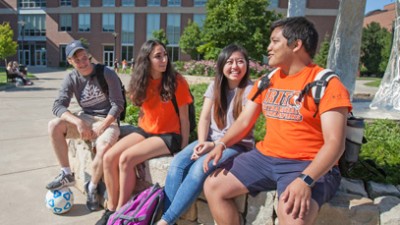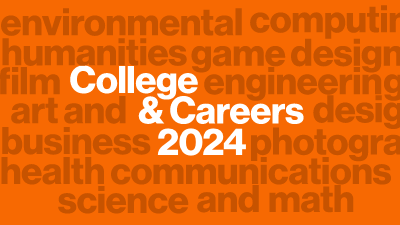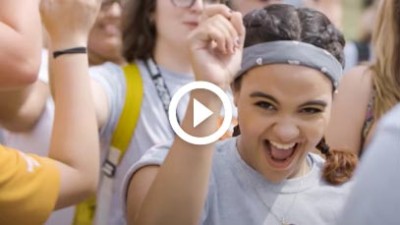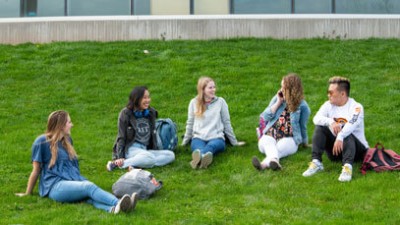Art of Science/Science of Art Minor - Curriculum
Art of Science/Science of Art Minor
| Course | |
|---|---|
| Required Course | |
| Integrative Seminar | |
| CLRS-101 | Art of Science of Art Art of Science of Art is a weekly forum in which students will be introduced to and discuss historical and current topics relating art and science with one another. Examples might include understanding human perception of the world in comparison with artistic renderings, the effects of lighting on the permanence and appearance of artwork, the creation of artists’ materials (e.g. the science of pigments), and art conservation/restoration in the physical and digital domains. This seminar provides an introductory and over-arching context for students in the Art of Science / Science of Art minor. It focuses on journal club discussions of readings selected by the students and faculty. It also includes oral presentations from students and faculty as well as visiting speakers from within and external to RIT. Students will complete oral presentations and written assignments based on the course readings and independent research. Lecture 1 (Spring). |
| Students must complete a total of three courses with one course coming from each of the following groups: | |
| Sciences | |
| CLRS-201 | Color Science for the Visual Arts Color has been a topic of intense interest and inquiry for thousands of years. Knowledge of color science can be an aid to visual artists and those who study the visual arts such as art historians and conservators. Topics include the building blocks of color, seeing color, producing color, displaying color, reproducing color, and conserving color. Lecture 3 (Spring). |
| IMGS-111 | Imaging Science Fundamentals This course is an exploration of the fundamentals of imaging science and the imaging systems of the past, present, and future. Imaging systems studied include the human visual system, consumer and entertainment applications (e.g., traditional and digital photography, television, digital television, HDTV, and virtual reality); medical applications (e.g., X-ray, ultrasound, and MRI); business/document applications (e.g., impact and non-impact printing, scanners, printers, fax machines, and copiers) and systems used in remote sensing and astronomy (e.g., night-vision systems, ground- and satellite-based observatories). The laboratory component reinforces the principles and theories discussed in the lecture, while giving students experience with many imaging systems and exposure to the underlying scientific principles. Lab 3, Lecture 2 (Fall). |
| IMGS-221 | Vision & Psychophysics This course presents an overview of the organization and function of the human visual system and some of the psychophysical techniques used to study visual perception. (This course is restricted to IMGS-BS, DIGCIME-BS, IMGS-MN and SCIMGS-IM students.) Lecture 3 (Fall, Spring). |
| SOFA-103 | Introduction to Imaging and Video Systems This course provides an introductory overview of the basic engineering and scientific principles associated with imaging systems. Topics covered include imaging physics, photographic science, human vision and perception, image capture and display technologies (both analog and digital), and digital image processing. This course is taught using both mathematical and phenomenological presentation and prepares students to proceed with more in-depth investigation of these fields in subsequent imaging science and motion picture science courses. Accompanying laboratory exercises provide hands-on experience with the presented concepts. (Co-requisite: MATH-171 or MATH-181 or MATH-181A or equivalent course.) Lab 3, Lecture 2 (Fall or Spring). |
| Arts | |
| ITDI-211 | Drawing for Non-Majors This class is devoted to developing basic skills in drawing. Formal art elements, mark making, observational skills, and personal expression will be stressed. Students will engage in issues of representation and abstraction through relationships of marks, lines and other graphic notations. **Fee: A materials fee is required for this course, and an additional course fee applied via student account** (Prerequisites: Students may not take ITDI-211 if they have already taken FDTN-111.) Studio 6 (Fall or Spring). |
| IDEA-221 | Design for Non-Majors I This course is a structured, cumulative introduction to the basic elements and principles of two-dimensional design for non-majors. This course will focus on the development of both a visual and verbal vocabulary as a means of exploring, developing and understanding 2D compositions. The course addresses a wide variety of media, tools, techniques both traditional and technological, and theoretical concepts to facilitate skill development and experimentation with process. This course may help in building a portfolio. (This course is open to all undergraduate students except those in FNAS-BFA, ILLM-BFA, ILLS-BFA, NMDE-BFA, GRDE-BFA, IDDE-BFA, INDE-BFA, 3DDG-BFA, CCER-BFA, GLASS-BFA, METAL-BFA, WOOD-BFA, PHIMAG-BFA, STAR-BFA and PHTILL-BFA.) Studio 5 (Fall, Spring). |
| CCER-128 | Josiah Wedgwood's Legacy This course will examine the evolution of 18th-century European ceramics under the influence of Josiah Wedgwood’s innovative spirit. Considered widely to be the father of modern marketing and manufacturing, potter, social activist, and politician Josiah Wedgwood built an empire from utilitarian objects underpinned by complex relationships between ceramics, technology, and culture. Through a combination of research-based exploration and hands-on, immersive learning, students will develop an understanding of the impact ceramics manufacturing had on such phenomena as social dynamics, social class, business practices, technologies that spurred advanced manufacturing, division of labor, and Neoclassical style. At the conclusion of this course, students will understand the significance of clay within history, the impact of pottery on culture in the age of imperialism, and how Wedgwood’s innovations endure today in the contemporary practices of studio pottery, ceramic manufacturing, and art. **This course requires a lab fee.** (This course is available to undergraduate students.) Lecture 2, Studio 3 (Fall or Spring). |
| PHAR-150 | Introduction to Film Photography An introduction to technical, aesthetic, and conceptual topics in black-and-white still photography for non-photography majors. Through weekly assignments, students will become familiar with the operation of a 35mm camera body, lenses, and film processing and printing, while exploring basic principles of lighting, depth of field, principles of design, blur, stop motion, exposure, and tone control. Lectures will address photographic aesthetics, in addition to historical, contemporary and innovative practices. Students will engage in the language of the critique through participation in discussions of photographic shooting assignments. Students are required to provide their own 35mm camera, film and processing, and photo paper. Non-Photo majors only. **Fee: This course has a facilities fee for Non-SPAS students** (This course is available to RIT degree-seeking undergraduate students.) Lab 3, Lecture 2 (Fall, Spring). |
| Humanities | |
| ARTH-136 | Survey: Renaissance to Modern In this course students will examine the forms, styles, functions, and meanings of important objects and monuments dating from the Renaissance through the beginning of the twentieth century, and consider these works of art in their social, historical and cultural contexts. The primary goals of this course are to learn how to look and how to describe and analyze what we see, and to use these skills to understand and explain how art visually expresses meaning. At the end of the term, students will have gained a foundational knowledge of the object, scope and methods of the discipline of art history. The knowledge obtained in this introductory course will also guide students in their own creative endeavors. Lecture 3 (Fa/sp/su). |
| MUSE-220 | Introduction to Museums This course examines the history, theory, and practice of museums by situating them as social institutions emerging within their broader historical and cultural contexts, from their origins in the mouseion of the classical era and Renaissance cabinets of curiosities to the modern era’s World’s Fairs and museums of today. The evolution and range of museum functions are addressed. Building on these foundations, the following types of museums and institutions are explored: art and design, natural history, anthropology, science, and history museums, as well as historic houses and sites, botanical gardens, and zoos. In studying the histories and functions of museums through the lenses of social institutions, the course highlights the evolution of museums institutionally, ideologically, and experientially. The course considers the operations of museums, governance, and the professional ethics and legal constraints that affect museum professionals; examines museums and their practices through the perspectives of colonialism and de-colonialization, nationalism, class, gender, ethnicity, anti-racism, and community; and includes field trips to local institutions and on-campus site visits throughout the semester. Lecture 3 (Fall). |
| MUSE-224 | History & Theory of Exhibitions Exhibitions are organized around a creative curatorial premise, a statement that articulates an idea allowing for the selection of work included in an exhibition. This course begins with an overview of exhibition history, starting with the transformation of the Louvre into the first public art museum following the French Revolution, where art history, a discipline developed in the 19th century, was enlisted to organize exhibitions. The class analyzes how art and exhibitions represent the cultural contexts in which they are created. The course examines the proliferation of types of exhibitions that accompanies modernism, up to the present, paying close attention to the curatorial premise animating the exhibitions. Lecture 3 (Spring). |
| MUSE-225 | Museums & the Digital Age The digital revolution has profoundly influenced how we think about the world around us. Information once available only to experts is now accessible digitally to a much broader audience. Museums, archives, and libraries have adapted to this democratization of knowledge and decentralization of access in myriad ways. As visitors to museums—whether online or onsite—each of us is part of the creation, consumption, and reception of digital information. What does this mean for museums and for us as audiences and consumers of such information? How has the combination of digital technology and social media increased visitors’ abilities for interaction with cultural institutions, their collections, and other visitors? This course will examine the history and evolution of museum practices as they adapt to new technologies and rethink traditional museum practices. The course has no pre-requisite and is open to students of all majors. Lecture 3 (Fall). |
| MUSE-226 | Introduction to Digital Cultural Heritage Cultural heritage is a fluid term that applies broadly to the creation, protection, and preservation of material objects and intangible practices for future generations. This course examines the concepts associated with tangible, intangible, and natural cultural heritage with a global outlook. Through readings, discussion, and projects, the course explores the various forms that cultural heritage takes and frames them in terms of digital creation, consumption, and preservation. Course content may be site-specific. Lecture 3 (Spring). |
| PSYC-224 | Perception This course covers perception in all of the sensory modalities (vision, hearing, taste, smell, touch). We will trace what happens to the physical stimulus as our sensory systems analyze it to produce complicated perceptions of the world around us. We will explore the fact that many complex perceptual phenomena draw upon explanations at the physiological, psychological, and cognitive levels. Topics on sensory perception in non-human animals may also be covered. This is a required course for psychology majors in the visual perception track. (Prerequisites: PSYC-101 or PSYC-101H or completion of one (1) 200 level PSYC course.) Lecture 3 (Fall, Spring). |
| Electives–Students must complete a total of two elective courses. At least two courses must be taken at the 300-level or higher. | |
| IMGS-351 | Fundamentals of Color Science This course will introduce students to the field of Color Science. Students will learn about the physical sources of color, the visual mechanisms that provide our experience of color, and the descriptive systems that have been developed for relating the physical and visual properties. Through hands-on projects, students will learn practical methods for measuring, modeling, and controlling color in digital imaging systems. (Prerequisites: SOFA-103 or equivalent course.) Lecture 3, Recitation 2 (Fall). |
| PSYC-222 | Biopsychology Introduction to the field of behavioral neuroscience, the study of neurobiological basis of cognition and behavior. Topics include neuroanatomy and physiology, localization of function, brain injury, research methods in behavioral neuroscience, and biological basis of language, memory, emotion, conscious states, and sexual behavior, with an evolutionary perspective. (Prerequisites: PSYC-101 or PSYC-101H or completion of one (1) 200 level PSYC course.) Lecture 3 (Fall, Spring). |
| PSYC-223 | Cognitive Psychology This course examines how people perceive, learn, represent, remember and use information. Contemporary theory and research are surveyed in such areas as attention, pattern and object recognition, memory, knowledge representation, language acquisition and use, reasoning, decision making, problem solving, creativity, and intelligence. Applications in artificial intelligence and human/technology interaction may also be considered. (Prerequisites: PSYC-101 or PSYC-101H or completion of one (1) 200 level PSYC course.) Lecture 3 (Fall, Spring, Summer). |
| ARTH-521 | The Image The image remains a ubiquitous, controversial, ambiguous and deeply problematic issue in contemporary critical discourse. This course will examine recent scholarship devoted to the image—a ubiquitous controversial, ambiguous and deeply problematic issue in contemporary critical discourse—and the ideological implications of the image in contemporary culture. Topics will include: the modern debate over word vs. image, the mythic origins of images, subversive, traumatic, monstrous, banned and destroyed images (idolatry and iconoclasm), the votive, the totem, and effigy, the mental image, the limits of visuality, the moving and projected image, the virtual image, dialectical images, image fetishism, the valence of the image, semiotics and the image, as well as criteria by which to assess their success or failure (their intelligibility) and their alleged redemptive and poetic power. Students will explore the theoretical framework of the concept of the image, and critically evaluate these theories within their broader intellectual and historical contexts. (Prerequisites: Completion of one course in Art History (ARTH) at the 100 level is required.) Lecture 3 (Fall or Spring). |
| ARTH-544 | Illuminated Manuscripts Students in this course will examine the history of illuminated manuscripts, learning about the working methods of artists as well as the cultural significance of the illuminated book. Issues of production, style, function, and patronage will be introduced, and students will explore the relationships between images, texts, and readers. Lecture 3 (Fall, Spring). |
| MUSE-340 | Introduction to Archival Studies This course introduces students to the role of archives in the construction of a society’s cultural heritage and historical identity. Archives are repositories of a culture’s original documents, both paper and electronic, and they function as a site for the construction, preservation, and dissemination of historical memory, as a source for social responsibility, and as a tool for the understanding of the cultural, social, and political forces that influence events. The course will examine the history of archives, the theory and practice that guide the work of archivists, and examine the basic components of an archival program: including acquisition and appraisal, arrangement and description, preservation and legal and ethical issues related to access to archival records. The class will also cover the transformation of the profession in the digital age, including digital preservation, the work of archival appraisal and collection building in an age of digital proliferation, and archival collection management systems. Lecture 3 (Fall). |
| MUSE-359 | Digital and Critical Curation This course introduces students to Cultural Informatics, the interdisciplinary field that examines the intersections of information technologies, information science, and cultural information centered in museums, libraries, and archives. Among the topics to be examined are: how information technologies are used in museums, libraries, and archives; how modern information systems have shaped the museum environment; the nature of convergence; the development of digital collections, digital curation, and online exhibitions; and the role and status of the information professional in the museum and cultural organizations. The course is designed around projects, case studies, and readings so that students gain hands-on experience working with information. The course has no prerequisite and is open to students of all majors. Lecture 3 (Fall). |
| MUSE-360 | Visitor Engagement & Museum Technologies All of us, as museum visitors, have the capacity to engage with collections and to create meanings as a result of such interaction. This course considers the history and theory of visitor engagement at museums, galleries, and sites of cultural heritage tourism; examines the import of technology into this history; and articulates the role of visitors as participants who curate their own experiences. Two key questions will be addressed in this course: 1) How does technology provide a platform for contribution, collaboration, co-creation, and co-opting of experiences among all visitors? and 2) Can technology mediate the best possible experience for visitors? The course has no prerequisite and is open to students of all majors. Lecture 3 (Spring). |
| MUSE-361 | Tablet to Tablet: A History of Books From ancient clay and wax tablets, to scrolls and medieval manuscripts, to printed books and iPads, this class examines the history of books from 2300 BCE to the present. Students study books not only as vehicles for texts, but also as physical artifacts that carry with them important evidence of the cultures that produced and read them. Using the Cary Graphic Arts Collection as their research laboratory, students investigate the evolution of books through hands-on interaction with artifacts both ancient and modern, while also pondering what forms future books might take. Lecture 3 (Spring). |









